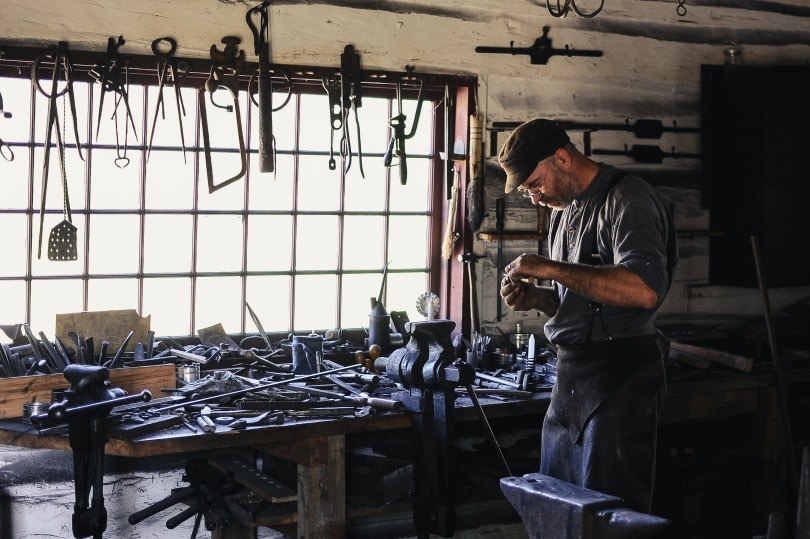If you have a pond or live on a lake, you know the scourge of aquatic weeds. They can take over a water body quickly. In the process, they’ll take any fish or beneficial plants with them. Maintenance is imperative to keep the water chemistry within healthy parameters. One effective way to handle the weeds is to use a pond rake.
This tool will remove the plants and clear the water. It’ll also make it more pleasant to fish, participate in water sports, or just float on a raft. Many products work well, but often they’re expensive. That’s what makes this YouTube video such a valuable find. You can easily make one yourself for a fraction of the cost. Our guide will show you how quickly you can go from a weed-filled pond to a clear one.

The 7 Steps to Make a DIY Pond Rake
1. Gather Your Supplies.
The beauty of this project is that you can repurpose scrap and get some use out of it. The design is also flexible. You can cut it to size for whatever you need for your situation. It does require some skills, and welding experience is essential. However, the tool comes together quickly to get you on the road to a healthier pond. The supplies you’ll need include:

- Scrap piece of angle iron or rebar
- U-hook
- Welding supplies
- Angle grinder
- Rasp
- Anchor rope
The length of the rope depends on the depth of your pond and what you’ll use to pull the rake through the water. The video recommends 200 feet of 800-strength rope. That’s a good size that will cover most situations. The general rule of thumb is 8 feet of line per 1 foot of depth. The length that the video suggests is probably a better choice than going with a formula.
Consider how far you’ll have to stand or drive your vehicle from the shoreline. Often ponds and lakes are lined with wetlands that can make it difficult to get close to the edge.
2. Cut and Weld the Rake to Size
You can cut the angle bar or rebar to size with an angle grinder. The rake in the video is quite wide, but then again, so is the area that the individual must cover. We suggest basing it on the size of the vehicle that will pull it out of the water. He’s using a tractor. You can go shorter if you’re using a four-wheeler. First, you will smooth out the edges with a rasp or grinder.
3. Weld a U-Hook on the Base.
The U-hook will provide the attachment point for the rope. It’s also a handy carrying handle, as the user shows. We recommend not skimping on this part of the project. If you’re hauling a large load, you’ll need the extra strength to avoid it snapping off and creating a dangerous situation with the rope coming back to the shore.

4. Tie the Desired Rope Length in the U-Hook.
The user recommends 200 feet of rope, but you can modify the design. We can easily see making a pond rake for a motorized vehicle and a smaller one for pulling by hand around docks or protected habitats. We prefer using nylon rope because it’s flexible yet strong for the task. We also like braided versus twisted since it’s easier for you to work with and handle.
5. Haul Out the Rake to the Far Edge of the Pond.
The user uses a kayak to haul the rake into the water. That’s an excellent choice, considering the weight of the tool. We can see how it would be unwieldy to toss out into the drink like an anchor. It’ll also allow you to control where you’re using it. Let’s face it. This task isn’t about being gentle. It’s about getting the job done in the quickest amount of time.
6. Pull the Rake Through the Water Using a Four-Wheeler or Tractor.
The vehicle depends on the size of the rake. Surprisingly, some submerged aquatic vegetation is quite tenacious and will make you work to get it out of the water. We recommend going slow as you pull it. It can give suddenly and create a hazard. It’ll also give you a chance to gauge its strength so that you can make any necessary adjustments.
7. Remove and Compost the Debris.
You’ll likely find that this DIY pond rake will remove a lot of vegetation, especially during the first few runs. That was evident when the user demoed the tool. We suggest composting what you collect since you’ll likely have a lot of invasive plants in each bunch. We also recommend using gloves to protect your hands. Be sure to keep an eye out for critters like Northern Water Snakes, which will probably bite.
Here’s Why You Need a Pond Rake
A pond rake will help you get the most out of your waterfront property. It’ll make it easier to use the shoreline, which often can get clogged with native and invasive plants, such as cattails. It’ll help you keep the water chemistry at healthier levels when you remove rotting vegetation that can foul the water. That’ll make for better fishing and swimming, which is more fun.

Final Thoughts
A DIY pond rake is an excellent way to maintain your pond or shoreline. The design of the tool in this video is simple yet effective. It just goes to show that you don’t need anything fancy to get the job done. However, it’s still a labor-intensive task, no matter what you use. This one makes it less painful with a more affordable product.
Featured Image Credit: emirkrasnic, Pixabay
